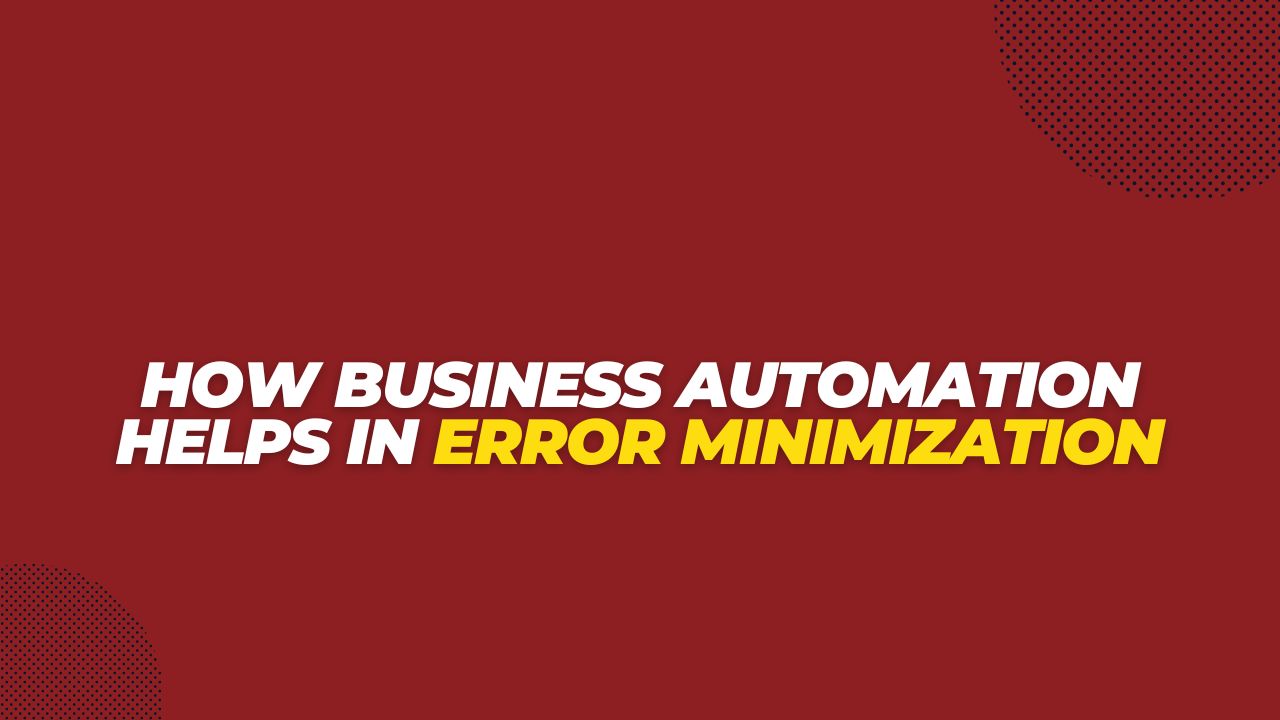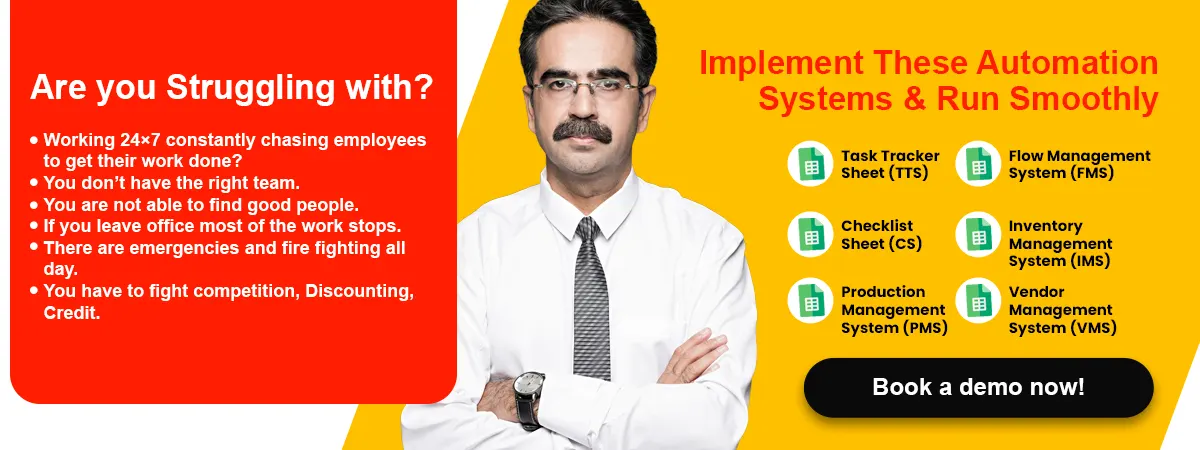by Subhadeep Chowdhury
Share

Today in the fast-paced business landscape, efficiency, and accuracy are paramount for success. However, manual processes are prone to errors, which can be costly and time-consuming to rectify. This is where business automation steps in as a game-changer.
By streamlining repetitive tasks and minimizing human intervention, automation not only enhances productivity but also significantly reduces the likelihood of errors.
How Business Automation Helps in Error Minimization
So, here, in this blog post, we delve into the transformative power of business automation and how it aids in error minimization, paving the way for smoother operations and increased profitability.
Let’s dive deep into this blog to learn more.
Understanding Errors in Business Processes
Understanding Errors in Business Processes is crucial for implementing effective strategies to minimize them and improve overall efficiency. There are two primary types of errors: Human Errors and System Errors.
Human Errors refer to mistakes made by individuals involved in business processes. These errors can stem from various factors such as lack of attention, miscommunication, fatigue, or insufficient training. Examples include data entry mistakes, miscalculations, and misinterpretation of instructions. While humans are an integral part of business operations, they are also prone to errors due to their inherent limitations.
On the other hand, System Errors are mistakes arising from flaws in technology or automated systems used in business processes. These errors may result from software bugs, hardware malfunctions, or inadequate system design. System errors can lead to disruptions in workflow, incorrect data processing, and system crashes, impacting productivity and customer satisfaction.
Also read: What Are The Impacts Of Improper Workflow In Business?
The consequences of errors in business processes can be significant and far-reaching. They can result in financial losses, reputational damage, regulatory non-compliance, and loss of customer trust. For instance, a billing error can lead to revenue loss and customer dissatisfaction, while a data breach due to a system error can compromise sensitive information, resulting in legal consequences and damage to the company’s reputation.
Common causes of errors in business processes include inadequate training, complexity of tasks, lack of standardization, poor communication, outdated technology, and inadequate quality control measures. Identifying these root causes is essential for developing strategies to prevent errors and improve process efficiency.
By understanding the types, consequences, and common causes of errors in business processes, organizations can proactively address them through measures such as training programs, process improvements, technology upgrades, and implementing robust quality assurance mechanisms. This understanding lays the foundation for successful error minimization efforts, leading to enhanced productivity, cost savings, and improved customer satisfaction.
Business Automation: The Solution to Error Minimization
What is Business Automation?
Business automation is the process of using technology to streamline and automate repetitive tasks and workflows within an organization, with the aim of increasing efficiency, reducing errors, and improving overall productivity. It involves the use of software applications, robotics, artificial intelligence, and other technologies to automate manual processes that are prone to errors when performed by humans alone.
At its core, business automation involves identifying tasks and processes that are repetitive, time-consuming, and prone to errors when performed manually. These tasks can range from data entry and processing to inventory management, customer service, and financial reporting. By automating these tasks, organizations can significantly reduce the likelihood of errors and improve the accuracy and reliability of their operations.
How Business Automation Works?
Business automation works by replacing manual labor with technology-driven solutions that can perform tasks faster, more accurately, and consistently. This is achieved through the use of software applications, algorithms, and robotic process automation (RPA) tools that can mimic human actions and decision-making processes. For example, instead of manually inputting data into a spreadsheet or database, automation software can be programmed to extract data from various sources, process it, and update the database automatically, eliminating the risk of human error.
Furthermore, business automation can involve the integration of different systems and applications within an organization to create a seamless workflow. For instance, automation tools can be used to integrate customer relationship management (CRM) systems with email marketing platforms, enabling automated communication with customers based on predefined triggers and criteria. This not only saves time but also ensures consistency and accuracy in customer interactions.
Also read: Importance, Challenges & Benefits Of Business Process Automation
Another aspect of business automation is the use of artificial intelligence (AI) and machine learning algorithms to automate decision-making processes and tasks that require complex analysis. AI-powered systems can analyze large volumes of data, identify patterns, and make predictions or recommendations based on predefined rules or machine learning models. This can be particularly useful in areas such as fraud detection, risk assessment, and demand forecasting, where human judgment may be subjective or prone to bias.
So, in essence, business automation offers a solution to error minimization by leveraging technology to automate repetitive tasks, streamline workflows, and improve overall efficiency and accuracy. By replacing manual labor with automated solutions, organizations can reduce the risk of errors, improve process consistency, and free up employees to focus on more value-added tasks.
The Role of Business Automation in Error Minimization:
In the realm of modern business operations, error minimization is a critical goal. Errors, whether minor or significant, can lead to wasted resources, dissatisfied customers, and damaged reputations. Fortunately, business automation offers a robust solution to this challenge.
Here is how:
-
Standardization of Processes:
Business automation entails establishing uniformity across workflows and processes. Through the establishment of precise guidelines and parameters, automation creates a structured framework that minimizes the potential for human error. This structured approach ensures that tasks are carried out with consistency and precision, leaving little room for discrepancies or oversights. By adhering strictly to predefined protocols, automation effectively safeguards against errors, thus enhancing operational efficiency and reliability. Consequently, businesses can operate more seamlessly, confident in the reliability and accuracy of their automated processes.
Also read: Common Small Business Challenges And How To Overcome Them
-
Reduction of Manual Intervention:
At each juncture of a process, human involvement presents an inherent risk of error. However, the integration of automation significantly diminishes the necessity for manual intervention, consequently reducing the probability of mistakes. Automated systems execute tasks with meticulous precision, adhering rigorously to predetermined algorithms and regulations. By relinquishing the reliance on human judgment and execution, businesses can mitigate the likelihood of errors permeating their operations. Automated processes operate seamlessly and consistently, without succumbing to fatigue or oversight. This meticulous adherence to predefined protocols ensures that tasks are completed accurately and efficiently, bolstering overall productivity and reliability within the organizational framework.
-
Real-time Monitoring and Alerts:
Automated systems possess the capability to actively monitor operations in real-time, swiftly identifying any anomalies or deviations from anticipated outcomes. This proactive monitoring enables prompt intervention to rectify errors before they escalate, thereby curtailing their adverse effects on business operations. By promptly addressing discrepancies as they arise, automated systems effectively mitigate potential disruptions and uphold the continuity of workflows. This preemptive approach not only safeguards against potential losses but also fosters a culture of efficiency and reliability within the organizational framework. Consequently, businesses can maintain optimal performance levels and uphold their commitment to delivering high-quality products or services to customers.
-
Data Accuracy and Integrity:
Informed decision-making hinges on the accuracy of data, making it a cornerstone of successful business operations. Business automation plays a pivotal role in safeguarding data integrity by eradicating the potential for manual data entry errors and discrepancies. Through automated data validation and verification mechanisms, the reliability of information is fortified, instilling confidence among stakeholders. These mechanisms meticulously scrutinize data, ensuring that it meets predefined standards before being utilized for decision-making purposes.
By eliminating the margin for human error and enhancing the accuracy of data processing, automation empowers organizations to make strategic decisions based on trustworthy and dependable information. This fosters a culture of transparency and accountability, bolstering the overall efficacy of business processes and facilitating sustainable growth.
-
Error Identification and Root Cause Analysis:
In moments when errors inevitably surface, business automation serves as a catalyst for swift identification and thorough analysis of their underlying causes. Automated systems meticulously record and document each step of a process, creating a comprehensive trail of activities. This meticulous documentation allows stakeholders to trace errors back to their origins with pinpoint accuracy, enabling them to discern patterns and identify systemic issues.
Armed with this insight, organizations can swiftly implement targeted corrective measures, addressing root causes rather than merely treating symptoms. By leveraging automation in error resolution processes, businesses cultivate a culture of continuous improvement, fostering resilience and adaptability in the face of challenges. Ultimately, this proactive approach not only minimizes the impact of errors on operations but also paves the way for sustained optimization and enhancement of business processes.
-
Enhanced Compliance and Risk Management:
In today’s regulatory landscape, businesses face stringent compliance requirements and regulatory standards. Non-compliance can have dire consequences, ranging from hefty financial penalties to irreparable damage to reputation. However, business automation offers a robust solution by enforcing predefined rules and protocols, thereby ensuring adherence to compliance standards. Automated systems meticulously monitor processes, flagging any deviations from regulatory requirements in real time. By streamlining compliance procedures and minimizing the potential for human error, automation reduces the risk of non-compliance incidents. This proactive approach not only safeguards businesses from legal and financial repercussions but also fosters trust and credibility with stakeholders, solidifying the organization’s reputation as a responsible and reliable entity in the market.
Future Trends in Business Automation for Error Minimization
Future trends in business automation are continuously evolving, with advancements in technology driving innovative solutions for error minimization. Several key trends are shaping the future of business automation:
- Artificial Intelligence (AI) and Machine Learning (ML) are poised to play a significant role in error minimization. AI algorithms can analyze vast amounts of data to identify patterns and trends, enabling organizations to anticipate and prevent errors before they occur. ML algorithms can learn from historical data to make predictions and automate decision-making processes, reducing the likelihood of human error. For example, AI-powered systems can detect anomalies in financial transactions to prevent fraud or predict equipment failures in manufacturing processes to prevent downtime.
- Robotic Process Automation (RPA) continues to gain traction as a key technology for error minimization. RPA software bots can automate repetitive tasks and workflows by mimicking human actions across multiple systems and applications. By reducing manual intervention, RPA can minimize errors and improve process efficiency. For instance, RPA bots can automate data entry tasks, invoice processing, and customer service inquiries, reducing the risk of human error and speeding up response times.
- The Internet of Things (IoT) is enabling the automation of physical processes and systems, further enhancing error minimization efforts. IoT devices embedded with sensors can collect real-time data from equipment, machinery, and environments. This data can be analyzed to identify potential errors or issues and trigger automated responses. For example, IoT-enabled predictive maintenance systems can monitor the performance of equipment and schedule maintenance tasks before failures occur, minimizing downtime and preventing costly errors.
- Predictive analytics is becoming increasingly sophisticated, allowing organizations to anticipate and mitigate errors proactively. By analyzing historical data and identifying patterns, predictive analytics algorithms can forecast future events and trends. This enables organizations to take preemptive action to prevent errors before they occur. For example, predictive analytics can forecast demand for products or services, optimize inventory levels, and identify potential supply chain disruptions, reducing the risk of errors and improving operational efficiency.
NOTE:
In today’s fast-paced business environment, the quest for efficiency and accuracy is paramount. This is where business automation emerges as a game-changer. By leveraging automated tools and systems, companies can significantly minimize errors across various operations. From data entry to inventory management, automated workflows not only streamline processes but also reduce the likelihood of human errors. Such precision translates into tangible benefits like improved customer satisfaction, reduced operational costs, and increased productivity. At Econstra, we understand the critical role of error minimization in driving business success. Our comprehensive business consultancy services not only identify areas for automation but also provide tailored solutions to optimize your processes. With Econstra’s expertise and cutting-edge automation tools, you can elevate your operations to new heights of efficiency and accuracy, gaining a competitive edge in today’s dynamic marketplace.
The Final Thoughts On How Business Automation Helps in Error Minimization
In conclusion, the integration of business automation into organizational workflows is instrumental in error minimization. By standardizing processes, reducing manual intervention, enabling real-time monitoring, ensuring data accuracy, facilitating error identification, and enhancing compliance, automation significantly mitigates the risks associated with human error.
Businesses that embrace automation not only streamline their operations but also foster a culture of efficiency and excellence. As technology continues to evolve, leveraging automation will become increasingly indispensable for staying competitive in today’s dynamic market landscape.
Embrace the power of automation and unlock new levels of productivity, accuracy, and success for your business.
STAY IN THE LOOP
Subscribe to our free newsletter.
Business consultant services provide the strategic insight and expertise necessary to steer your company through various challenges and opportunities. These professionals play a crucial role in helping businesses identify growth opportunities, optimize operations, and achieve long-term success. Understanding the Role of a Business Consultant A business consultant acts as an external advisor who brings a […]
In today’s competitive business landscape, companies are constantly seeking ways to reduce operational costs while maintaining or improving efficiency and customer satisfaction. Customer Relationship Management (CRM) systems have emerged as vital tools that enable businesses to achieve these goals. As a leading business consultancy, Econstra understands the importance of leveraging CRM technology to streamline operations, […]
Why Operational Costs Are Draining Your Profits? Operational costs are a critical aspect of running a successful business, but when not managed properly, they can drain your profits and stifle growth. In a competitive market, maintaining profitability requires keen oversight of expenses and strategic planning. Econstra, as a leading business consultancy, provides insights and strategies […]
In the rapidly advancing digital landscape, Artificial Intelligence (AI) tools have emerged as transformative assets for businesses. Their potential to enhance efficiency, streamline operations, and drive innovation makes them invaluable for business consultants and organizations worldwide. For business consultants in India, AI’s strategic application can be particularly advantageous in navigating a diverse and dynamic market. […]





